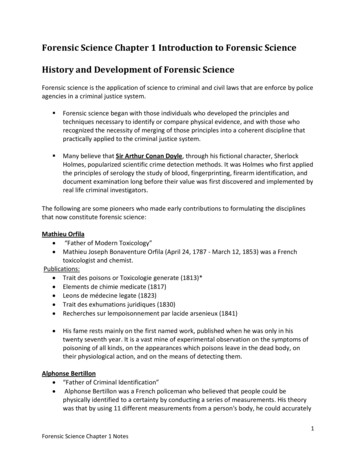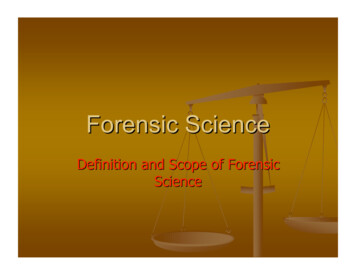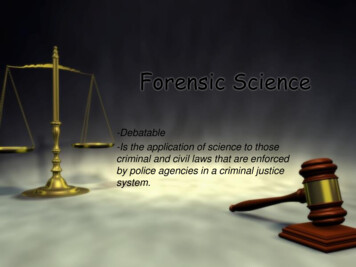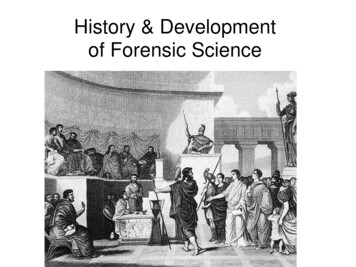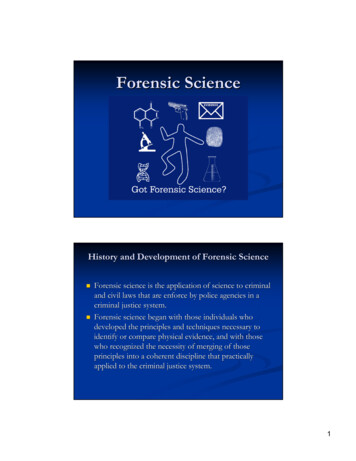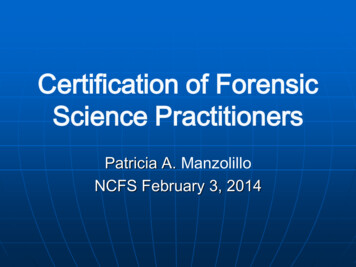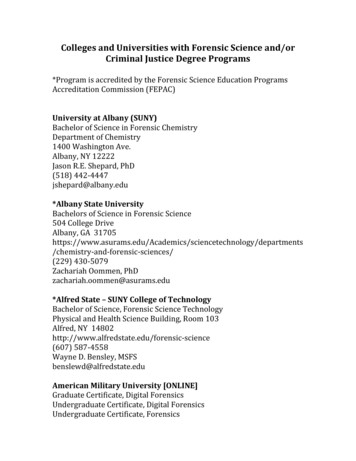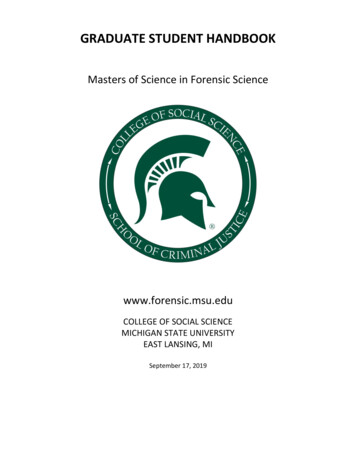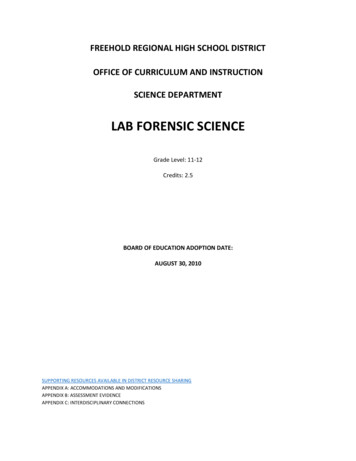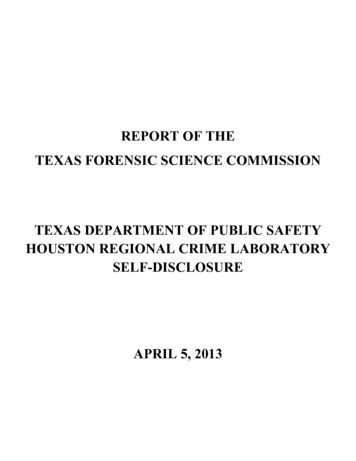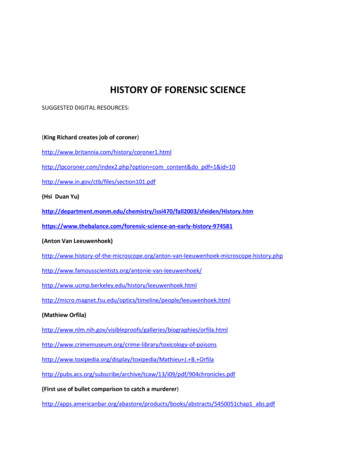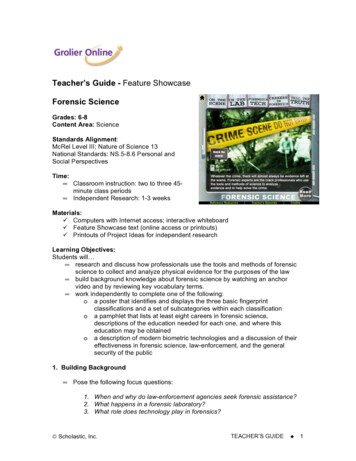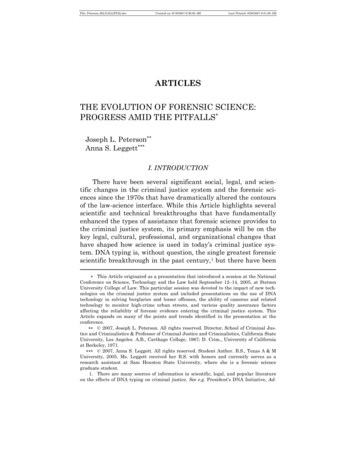
Transcription
File: Peterson.362.GALLEY(h).docCreated on: 9/19/2007 9:36:00 AMLast Printed: 9/26/2007 9:51:00 AMARTICLESTHE EVOLUTION OF FORENSIC SCIENCE:PROGRESS AMID THE PITFALLS Joseph L. Peterson Anna S. Leggett I. INTRODUCTIONThere have been several significant social, legal, and scientific changes in the criminal justice system and the forensic sciences since the 1970s that have dramatically altered the contoursof the law-science interface. While this Article highlights severalscientific and technical breakthroughs that have fundamentallyenhanced the types of assistance that forensic science provides tothe criminal justice system, its primary emphasis will be on thekey legal, cultural, professional, and organizational changes thathave shaped how science is used in today’s criminal justice system. DNA typing is, without question, the single greatest forensicscientific breakthrough in the past century,1 but there have been This Article originated as a presentation that introduced a session at the NationalConference on Science, Technology and the Law held September 12–14, 2005, at StetsonUniversity College of Law. This particular session was devoted to the impact of new technologies on the criminal justice system and included presentations on the use of DNAtechnology in solving burglaries and lesser offenses, the ability of cameras and relatedtechnology to monitor high-crime urban streets, and various quality assurance factorsaffecting the reliability of forensic evidence entering the criminal justice system. ThisArticle expands on many of the points and trends identified in the presentation at theconference. 2007, Joseph L. Peterson. All rights reserved. Director, School of Criminal Justice and Criminalistics & Professor of Criminal Justice and Criminalistics, California StateUniversity, Los Angeles. A.B., Carthage College, 1967; D. Crim., University of Californiaat Berkeley, 1971. 2007, Anna S. Leggett. All rights reserved. Student Author. B.S., Texas A & MUniversity, 2005. Ms. Leggett received her B.S. with honors and currently serves as aresearch assistant at Sam Houston State University, where she is a forensic sciencegraduate student.1. There are many sources of information in scientific, legal, and popular literatureon the effects of DNA typing on criminal justice. See e.g. President’s DNA Initiative, Ad-
File: Peterson.362.GALLEY(h).doc622Created on: 9/19/2007 9:36:00 AMStetson Law ReviewLast Printed: 9/26/2007 9:51:00 AM[Vol. 36several other key changes, such as the following: landmark Supreme Court decisions have modified how our courts evaluate andadmit scientific evidence;2 professional initiatives have addressedthe credentials of forensic examiners, the quality of laboratoryoperations, and the accuracy of scientific evidence testing;3 andlegal and popular culture has created an unprecedented awareness of, and appetite for, forensic science.4Still, we cannot disregard factors that seriously limit the fullusage of the forensic sciences by our justice system. We pour resources into DNA typing but fail to devote the necessary funds tothe collection and analysis of other types of evidence in crimelaboratories. Backlogs of evidence awaiting analysis in crimelaboratories slow the judicial process. We also have recurring reports of poorly trained and equipped forensic scientists who makeerrors in their examinations of evidence and indications of otherexaminers who shape their results to satisfy the desires of partiesto a case.5 We have created standards that, if followed, can lift upthe quality of forensic science, but our legal institutions havefailed to mandate that the standards be satisfied by examinerswho submit their reports and give testimony in our courts. In fact,it is only logical that high scientific standards should be invokedbefore scientific evidence is allowed in court, but judges and lawyers have not insisted that those criteria be met in every case.6vancing Justice through DNA Technology, ative policy book.pdf (accessed Sept. 24, 2006) (discussing scientific articles and casestudies, and providing detailed information for investigators, officers of the court, andpolicy-makers regarding the advancement of DNA technology).2. See generally Kumho Tire Co. v. Carmichael, 526 U.S. 137 (1999) (holding thatDaubert applies to all types of expert testimony); Gen. Electric Co. v. Joiner, 522 U.S. 136(1997) (holding that the trial court did not abuse its discretion by refusing to admit evidence that did not meet the Daubert standard); Daubert v. Merrell Dow Pharms., Inc., 509U.S. 579 (1993) (rejecting the Frye standard for admitting scientific evidence and suggesting a series of factors for admitting relevant and reliable scientific evidence).3. Jan S. Bashinski & Joseph L. Peterson, Forensic Sciences, in Local GovernmentPolice Management 559 (William Geller & Darrel Stephens eds., 4th ed., Intl. City/Co.Mgt. Assn. 2003).4. Max M. Houck, CSI: Reality, 295 Sci. Am. 84 (July 2006).5. Paul C. Giannelli, Scientific Evidence, 18 Crim. Just. Mag. (Spring 2003) (availableat ic evidence.html); Paul C. Giannelli,“Junk Science”: The Criminal Cases, 84 J. Crim. L. & Criminology 105, 113–117 (1993)[hereinafter Giannelli, Junk Science].6. Peter D. Barnett, The Role of Standards in Forensic Science, 23 ASTM Standardization News 24 (Apr. 1995); John J. Lentini, Standardization in the Criminalistics Laboratory, 23 ASTM Standardization News 34 (Apr. 1995); Michael J. Saks, The Legal and Sci-
File: Peterson.362.GALLEY(h).doc2007]Created on: 9/19/2007 9:36:00 AMLast Printed: 9/26/2007 9:51:00 AMThe Evolution of Forensic Science623It has been recognized for decades that scientists and lawyersdo not think and reason alike and that they employ differentvalue systems in their treatment and interpretation of evidence.7The adversarial legal process, with its high premium on winningcases, allows advocates to employ and promote dubious science ifit serves their clients’ needs and helps them prevail in the courtroom.8 This Article will address a number of major forces thathave influenced this dynamic field over the past thirty years, andit will offer suggestions as to where we need to concentrate ourefforts to ensure that scientific truth reaches the factfinder on aregular basis.II. THE 1970s: AN INCREASE IN CRIME ANDGROWTH IN CRIME LABORATORIESIn terms of the criminal justice system’s use of forensic science, several factors emerged in the 1970s that influenced thedirection of forensic science. The nation experienced a dramaticincrease in crime in the late 1960s and early 1970s, with allcrimes increasing eighty-three percent from 1966 to 1971, andviolent crimes alone rising ninety percent during this same period.9 Americans were alarmed and insisted that their politicalrepresentatives take action. The report of the President’s Commission on Law Enforcement and Administration of Justice, published in 1967,10 detailed the underlying social conditions drivingcrime upward, and the United States Congress passed the Omnibus Crime Control and Safe Streets Act11 in 1968 to provide massive funding to state and local law enforcement to attack the problem. Scientific crime laboratories and crime-scene technicianswere acknowledged as necessary to investigate and solve violententific Evaluation of Forensic Science (Especially Fingerprint Expert Testimony), 33 SetonHall L. Rev. 1167 (2003).7. Thomas A. Cowan, Decision Theory in Law, Science, and Technology, 140 Sci. 1065(1963).8. John I. Thornton, Uses and Abuses of Forensic Science, 69 ABA J. 289, 292 (Mar.1983); John I. Thornton, Criminalistics—Past, Present, and Future, 11 Lex et Scientia 1(1975).9. L. Patrick Gray, III, Uniform Crime Reports for the United States—1971, at 61(U.S. Govt. Printing Off. 1972).10. Pres. Commn. on L. Enforcement & Administration of Just., The Challenge ofCrime in a Free Society (U.S. Govt. Printing Off. 1967).11. Pub. L. No. 90-351, 82 Stat. 197 (1968).
File: Peterson.362.GALLEY(h).doc624Created on: 9/19/2007 9:36:00 AMStetson Law ReviewLast Printed: 9/26/2007 9:51:00 AM[Vol. 36crimes. As the President’s Commission predicted, “More andmore, the solution of major crimes will hinge upon the discoveryat crime scenes and subsequent scientific laboratory analysis oflatent fingerprints, weapons, footprints, hairs, fibers, blood, andsimilar traces.”12Drug abuse became a huge societal problem, and crime laboratories were needed to identify any suspected controlled substance to allow for a successful prosecution.13 Soon, drugs becamethe predominant type of evidence examined in laboratories, acondition that continues to the present day.14 In a number of significant cases decided in the 1960s, the United States SupremeCourt curbed certain police practices, such as the interrogation ofsuspects without first informing them that they had the right toremain silent, the right to counsel, and the right to have a lawyerprovided for them if they could not afford one.15 But in return, theCourt permitted the police to gather physical evidence from suspects without violating their Fifth Amendment rights.16 Policewere encouraged to rely more on scientific evidence and to avoidthird-degree tactics when securing confessions from suspects:We have learned the lesson of history, ancient and modern,that a system of criminal law enforcement which comes todepend on the “confession” will, in the long run, be less reliable and more subject to abuses than a system which de-12. Pres. Commn. on L. Enforcement & Administration of Just., Task Force Report:The Police 51 (U.S. Govt. Printing Off. 1967).13. Brian Parker & Joseph L. Peterson, Physical Evidence Utilization in the Administration of Criminal Justice 34 (Natl. Inst. L. Enforcement & Crim. Just. 1972).14. Id.15. See generally Miranda v. Ariz., 384 U.S. 436 (1966) (holding that a defendant’sstatements made during custodial police interrogation and without sufficient warning ofconstitutional rights were inadmissible because the statements violated the defendant’sFifth Amendment right against self-incrimination); Escobedo v. Ill., 378 U.S. 478 (1964)(holding that when a suspect is taken into custody, interrogated, denied the opportunity toconsult with an attorney, and not warned of his right to remain silent, he has been denied“[a]ssistance of [c]ounsel” in violation of the Sixth Amendment, and no incriminating statements may be used against him in a criminal trial).16. Schmerber v. Cal., 384 U.S. 757 (1966) (concluding that a blood sample taken froma defendant against his objection violated neither the Fifth Amendment privilege againstself-incrimination nor the Fourth Amendment right to be free from unreasonable searchesand seizures; therefore, the sample was admissible).
File: Peterson.362.GALLEY(h).doc2007]Created on: 9/19/2007 9:36:00 AMLast Printed: 9/26/2007 9:51:00 AMThe Evolution of Forensic Science625pends on extrinsic evidence independently secured throughskillful investigation.17The United States Congress created the Law EnforcementAssistance Administration (LEAA) in 1968, which channeled billions of dollars in federal aid to law enforcement during the1970s, and provided the funding for resources that police coulduse to recognize, collect, and analyze tangible evidence.18 Thenumber of forensic crime laboratories in the nation tripled (fromabout 100 to more than 300), and crime-scene units multiplied.19While the growth was necessary, it was unregulated and withoutclear guidance from, or adherence to, national standards. Thus,while crime-laboratory services expanded, some of the underlyingproblems of quality assurance and minimum scientific standardssimply multiplied.In addition to the “block grant” funding to the states, the research arm of the LEAA, the National Institute of Law Enforcement and Criminal Justice (NILECJ), began a modest forensicscience research program and supported several projects that willbe described in subsequent sections of this Article.20 LEAA stud17. Escobedo, 378 U.S. at 488–489.18. See generally Richard S. Allinson, LEAA’s Impact on Criminal Justice: A Review ofthe Literature, 11 Crim. Just. Abstracts 608, 647 (1979) (questioning whether the billionsof dollars pumped into the LEAA have produced “innovative” results); U. Research Corp.,Forensic Science Services and the Administration of Justice (Natl. Inst. L. Enforcement &Crim. Just. 1978) (summarizing a national workshop held to describe the problems in theforensic science field and offer solutions); Arnold E. Levitt, Crime Labs Expand as Business Flourishes, Chem. & Engr. News 16 (Jan. 3, 1972) (explaining the relationship between the growth in crime and the need to expand forensic laboratories); Alexander Joseph, Crime Laboratories—Three Study Reports, (U.S. Dept. of Just. 1968) (discussingthree studies that investigated the need for improved and more extensive laboratory resources, the status of laboratories in Massachusetts, and the pooling of laboratory resources).19. See Joseph L. Peterson, Steven Mihajlovic & Joanne L. Bedrosian, The Capabilities, Uses, and Effects of the Nation’s Criminalistics Laboratories, 30 J. Forensic Sci. 10(1985) (reporting on the results of a survey sent to crime laboratories across the UnitedStates) [hereinafter Peterson et al., Criminalistics Laboratories]; see generally BrianParker, The Status of Forensic Science in the Administration of Criminal Justice, 32 Rev.Juridica U. P.R. 405 (1963) (explaining that scientific investigation is used in a very lowpercentage of crimes); Joseph L. Peterson, The Utilization of Criminalistics Services by thePolice (U.S. Govt. Printing Off. 1974) (discussing the role of criminalistics as used by policeand criminal prosecutors in relation to the entire criminal justice system and explainingthe need for improved education and training).20. Charles R. Kingston, A National Criminalistics Research Program, in Law Enforcement Science and Technology vol. 3, 453–460 (S.I. Cohn & W.B. McMahon eds., IIT
File: Peterson.362.GALLEY(h).doc626Created on: 9/19/2007 9:36:00 AMStetson Law ReviewLast Printed: 9/26/2007 9:51:00 AM[Vol. 36ies demonstrated that police investigators used physical evidenceto a greater extent if the laboratories were placed in closer proximity to law-enforcement officers. As a result of such studies andthe availability of federal support, statewide systems of crimelaboratories were created that brought analytical capabilitiescloser to local law-enforcement agencies and the crime problem.21Organizational and professional relationships among federal,state, and local crime laboratories improved, as did the qualityand effectiveness of investigations. The operating crime laboratories drove the expansion and direction of this field with comparatively little consultation with or guidance from the legal and scientific academic communities. This trend continued for decades,and laboratories have only recently begun to address some of thefundamental problems of the field.A handful of studies emerged that demonstrated the severeneed for higher-education programs to prepare future forensicscientists for positions in government laboratories.22 Early crimelaboratories were staffed by chemists, biologists, and a combination of police professionals (firearms, toolmark, fingerprint, andquestioned-document examiners), as well as a few individualstrained in criminalistics at the University of California at Berkeley, Michigan State University, and John Jay College of CriminalJustice in New York. Although there was a rapid growth of college- and university-based criminalistics degree programs nationwide, there was little standardization of coursework or recognition of the need for minimum faculty qualifications.23 Even withthis growth, there were few centralized training opportunities,and most examiners were Bachelor of Science graduates who wereResearch Inst. 1970); Joseph L. Peterson, LEAA’s Forensic Science Research Program, inForensic Science (Geoffrey Davies ed., Am. Chem. Socy. 1975) [hereinafter Peterson,LEAA’s].21. C.J. Rehling & C.L. Rabren, Alabama’s Master Plan for a Crime Laboratory Delivery System (U.S. Govt. Printing Off. 1973); Walter Benson et al., Systems Analysis ofCriminalistics Operations (Midwest Research Inst. 1970); Pres. Commn. on L. Enforcement & Administration of Just., Task Force Report: Science and Technology (U.S. Govt.Printing Off. 1967).22. See generally Kenneth S. Field et al., Assessment of the Personnel of the ForensicScience Profession vol. 2 (U.S. Dept. Just. 1977) (surveying the educational needs of theyoung and growing field of forensic science).23. J.L. Peterson & P.R. De Forest, Status of Forensic Science Degree Programs in theUnited States, 22 J. Forensic Sci. 17, 25, 31 (1977).
File: Peterson.362.GALLEY(h).doc2007]Created on: 9/19/2007 9:36:00 AMThe Evolution of Forensic ScienceLast Printed: 9/26/2007 9:51:00 AM627trained on the job.24 John Jay College in New York, with federalNational Institute of Justice (NIJ) support, offered one of the firstprograms to offer practitioners advanced serological training in1970.25 Toward the end of the decade, the Forensic SciencesFoundation (FSF), again with federal NIJ support, coordinatedmuch-needed training in microscopy and serology.26Upon the death of J. Edgar Hoover in 1972, and the appointment of Clarence Kelley as the new Director of the Federal Bureau of Investigation (FBI) in 1973, the FBI entered a new era inwhich it actively cultivated professional and research relationships with state and local crime laboratories.27 It was during thistime period that the seeds were planted for a national accreditation program for crime laboratories.28 Kelley’s appointment alsointroduced more cooperation between the FBI and sister Department of Justice agencies like the LEAA, and the FBI began to offer more training and research opportunities at its Forensic Science Research and Training Center (FSRTC), which was established in 1981.29The small research program at the NILECJ focused on refining and developing new techniques and instrumentation, assessing the staffing needs of laboratories, and examining the operations of forensic laboratories and their interface with other criminal justice agencies.30 The FSF also received funding from theNILECJ in the late 1970s to establish certification boards in various forensic specialties like criminalistics, questioned documents,24. Id. at 31.25. See generally Bryan J. Culliford, The Examination and Typing of Bloodstains inthe Crime Laboratory (U.S. Govt. Printing Off. 1971) (describing scientific techniques forexamining blood in crime laboratories).26. The Forensic Sciences Foundation, Inc. received research grants in the late 1970sto coordinate training in microscopy (Forensic Microscopy Workshops) through theMcCrone Research Institute, and serology training in advanced bloodstain analysis techniques through the Serological Research Institute (SERI).27. Am. Socy. of Crime Laboratory Dirs., Laboratory Accreditation Bd., tory.html (accessed Aug. 15, 2007).28. Id.29. See generally William Y. Doran, The FBI Laboratory: Fifty Years, 27 J. ForensicSci. 743 (1982) (describing training and research opportunities at the FBI’s Forensic Science Research and Training Center); Clarence M. Kelley, FBI Assistance to the Law Enforcement Community, 42 Police Chief 40 (1975) (describing the various services the FBIprovides to local law enforcement agencies).30. Peterson, LEAA’s, supra n. 20.
File: Peterson.362.GALLEY(h).doc628Created on: 9/19/2007 9:36:00 AMStetson Law ReviewLast Printed: 9/26/2007 9:51:00 AM[Vol. 36toxicology, physical anthropology, odontology, and psychiatry.31The criminalistics profession, given its many subspecialties, wasthe last to agree on what education, training, and experientialstandards were ne
THE EVOLUTION OF FORENSIC SCIENCE: PROGRESS AMID THE PITFALLS Joseph L. Peterson Anna S. Leggett I. INTRODUCTION There have been several significant social, legal, and scien-tific changes in the criminal justice system and the forensic sci-ences since the 1970s that have dramatically altered the contours of the law-science .File Size: 250KB
